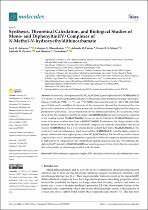| dc.contributor.author | Adeyemi, Jerry O. | |
| dc.contributor.author | Olasunkanmi, Lukman O. | |
| dc.contributor.author | Fadaka, Adewale O. | |
| dc.date.accessioned | 2022-09-19T07:53:01Z | |
| dc.date.available | 2022-09-19T07:53:01Z | |
| dc.date.issued | 2022 | |
| dc.identifier.citation | Adeyemi, J. O. et al. (2022). Synthesis, theoretical calculation, and biological studies of mono- and diphenyltin(iv) complexes of n-methyl-n-hydroxyethyldithiocarbamate. Molecules, 27(9), 2947. https://doi.org/10.3390/molecules27092947 | en_US |
| dc.identifier.issn | 1420-3049 | |
| dc.identifier.uri | https://doi.org/10.3390/molecules27092947 | |
| dc.identifier.uri | http://hdl.handle.net/10566/7907 | |
| dc.description.abstract | In this study, chlorophenyltin(IV) [(C6H5)(Cl)Sn(L)2] and diphenyltin(IV) [(C6H5)2Sn(L)2]
of N-methyl-N-hydroxyethyldithiocarbamate were prepared and characterized using various spectroscopic
methods (FTIR, 1H, 13C, and 119Sn NMR) and elemental analysis. The FTIR and NMR
spectral data, used to establish the structure of the compounds, showed the formation of the complexes
via coordination to the two sulfur atoms from the dithiocarbamate ligand and the respective
phenyltin(IV) derivatives. This coordination mode was further explored by DFT calculations, which
showed that the bonding around the Sn center in [(C6H5)2Sn(L)2] was more asymmetric compared
to the bonding around [(C6H5)(Cl)Sn(L)2]. However, the Sn–S bonds in [(C6H5)(Cl)Sn(L)2] were
found to be more covalent than those in [(C6H5)2Sn(L)2]. | en_US |
| dc.language.iso | en | en_US |
| dc.publisher | MDPI | en_US |
| dc.subject | Organic chemistry | en_US |
| dc.subject | Biotechnology | en_US |
| dc.subject | Dithiocarbamate | en_US |
| dc.subject | Molecular | en_US |
| dc.title | Synthesis, theoretical calculation, and biological studies of mono- and diphenyltin(iv) complexes of n-methyl-n-hydroxyethyldithiocarbamate | en_US |
| dc.type | Article | en_US |

